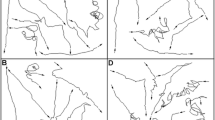Summary
A microbial growth medium, RSM, was developed to study the role of siderophores (microbial Fe-transport compounds) in the inhibition of the take-all pathogen, Gaeumannomyces graminis var. tritici, by Pseudomonas putida strain B10. The inorganic constituents of the medium were designed to mimic the rhizosphere while the organic composition was designed to promote rapid growth and siderophore production. The antibiosis experiments were highly reproducible and the antagonism appeared to be due to production of pseudobactin, the siderophore of B10. On plates amended with chrome azurol S, G. graminis did not produce siderophores while other fungi did. The growth of G. graminis on plates prepared with Fe chelate buffers was inhibited at a free ferric ion concentration of 10−24.6 M, although three other fungi were not inhibited, even at 10−25.5 M, presumably due to their greater production of siderophores. In liquid medium amended with Fe chelate buffers, both the doubling time and the lag phase of P. putida increased as the free ferric ion concentration was reduced. A wide variety of fungi and bacteria were found to grow on this medium. Because the inorganic composition of RSM is based on that of the rhizosphere, the development of this medium may be a first step towards the study of the chemistry and biology of the rhizosphere under well defined conditions.
Similar content being viewed by others
References
Balis C (1970) A comparative study of Phialophora radicicola, an avirulent fungal root parasite of grasses and cereals. Ann Appl Biol 66:59–73
Becker JO, Cook RJ (1988) Role of siderophores in suppression of Pythium species and production of increased-growth response of wheat by fluorescent pseudomonads. Phytopathology 78:778–782
Brand LE, Sunda WG, Guillard RRL (1983) Limitation of marine phytoplankton reproductive rates by zinc, manganese, and iron. Limnol Oceanogr 28:1182–1198
Brown ME (1974) Seed and root bacterization. Annu Rev Phytopathol 12:181–197
Chaney RL (1988) Plants can utilize iron from Fe-N,N′-di(2-hy-droxy-benzoyl)-ethylenediamine-N, N′-diacetic acid, a ferric chelate with 106 greater formation constant than Fe-EDDHA. J Plant Nutr 11:1033–1050
Chaney RL, Bell PF (1987) Complexity of iron nutrition: Lessons for plant-soil interaction research. J Plant Nutr 10:963–994
Chaney RL, Brown JC, Tiffin LO (1972) Obligatory reduction of ferric chelates in iron uptake by soybeans. Plant Physiol 50:208–213
Difco Laboratories (1953) Difco manual, 9th edn. Detroit, Mich
Gindrat PD (1968) Recherches sur la nutrition et le développement de Gaeumannomyces graminis (Sacs.) von Arx et Olivier, agent du piétin-échaudage des céréales. Schweiz Landwirtsch Forsch 7:197–214
Good NE, Winget GD, Winter W Connolly TN, Izawa S, Singh RMM (1966) Hydrogen ion buffers for biological research. Biochemistry 5:467–477
Janisiewicz WJ (1988) Biocontrol of postharvest diseases of apples with antagonist mixtures. Phytopathology 78:194–198
King EO, Ward MK, Raney DE (1954) Two simple media for the demonstration of pyocyanin and fluorescin. J Lab Clin Med 44:301–307
Koch AL (1981) Growth measurement. In: Gerhard P (ed) Manual of methods for general bacteriology. Am Soc Microbiol, Washington DC, pp 179–207
Kwok OCH, Fahy PC, Hoitink HAJ, Kuter GA (1987) Interactions between bacteria and Trichoderma hamatum in suppression of Rhizoctonia damping-off in bark compost media. Phytopathology 77:1206–1212
Lindsay WL (1979) Chemical equilibria in soils. Wiley, New York
Leong J (1986) Siderophores: Their biochemistry and possible role in the biocontrol of plant pathogens. Annu Rev Phytopathol 24:187–209
Mengel K, Grimme H, Nemeth K (1969) Potential and actual availability of plant nutrients in soils. Landwirtsch Forsch 23:79–91
Neilands JB (1981) Microbial iron compounds. Annu Rev Biochem 50:715–731
SAS Institute, Inc. (1987) SAS/STAT guide for personal computers, 6th edn. SAS Institute Inc., Cary, NC
Schwyn B, Neilands JB (1987) Universal chemical assay for the detection and determination of siderophores. Anal Biochem 160:47–56
Seifert KA, Hamilton WE, Breuil C, Best M (1987) Evaluation of Bacillus subtilis C186 as a potential biological control of sapstain and mould on unseasoned lumber. Can J Microbiol 33:1102–1107
Simeoni LA, Lindsay WL, Baker R (1987) Critical iron level associated with biological control of Fusarium wilt. Phytopathology 77:1057–1061
Speakman JB, Lewis BG (1980) Vitamin requirements of Phialophora radicicola var. graminicola compared with Gaeumannomyces graminis var. tritici. Trans Br Mycol Soc 74:410–413
Suslow TV, Schroth MN (1982) Rhizobacteria of sugar beets: Effects of seed application and root colonization on yield. Phytopathology 72:199–206
Teintze M, Hossain MB, Barnes CL, Leong J, van der Helm D (1981) Structure of ferric pseudobactin, a siderophore from a plant growth promoting pseudomonas. Biochemistry 20:6446–6457
Trinci APJ (1969) A kinetic study of the growth of Aspergillus nidulans and other fungi. J Gen Microbiol 57:11–24
Weller DM, Cook RJ (1983) Suppression of take-all of wheat by seed treatments with fluorescent pseudomonads. Phytopathology 73:463–469
West ES, Todd WR, Mason HS, Van Bruggen JT (1967) Textbook of biochemistry, 4th edn. Macmillan, New York
Whipps JM (1987) Effect of media on growth and interactions between a range of soil-borne glasshouse pathogens and antagonistic fungi. New Phytol 107:127–142
Wong PTW Baker R (1984) Suppression of wheat take-all and Ophiobolus patch by fluorescent pseudomonads from a Fusarium-suppressive soil. Soil Biol Biochem 16:397–403
Author information
Authors and Affiliations
Rights and permissions
About this article
Cite this article
Buyer, J.S., Sikora, L.J. & Chaney, R.L. A new growth medium for the study of siderophore-mediated interactions. Biol Fert Soils 8, 97–101 (1989). https://doi.org/10.1007/BF00257751
Received:
Issue Date:
DOI: https://doi.org/10.1007/BF00257751




